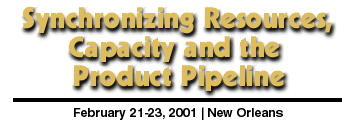How to balance project opportunities with time, capability, and
budget for overall profitability
Home 
Background 
Agenda 
Speaker List 
Presentations 
Workshops 
Benefits

How to Register 
Fees & Logistics 
Get a Brochure 
Special Offers

Event Sponsorship 
Contest Results 

|

Strategy, methods, IT tools, and cultural challenges
 Download Conference Brochure
(Sync2001.pdf - 630 kb)
Download Conference Brochure
(Sync2001.pdf - 630 kb)

Contest Details & Prize List |
Horror Stories |
Survey Results
Responses
Contact us at Management Roundtable
(info@roundtable.com) if you would like to respond to
anything you see here .
Horror
Story
| 1. |
#1
Bottleneck -- Lack of a Process / System to Rank Order the
"Candidate" projects, and then to Allocate EXISTING Human and
Capital Resources to this PRIORTIZED List until such time as the
AVAILABLE Resources are EXHAUSTED. Most Leadership Teams "Don't
have a Clue" as to WHEN they must SAY NO to a "New" Opportunity. |
Response #1
From Scott Elliott, Product Development Consulting, Inc.
[scott_elliott@pdcinc.com]
In our work, this problem is the most common bottleneck for
technical companies. The root causes are as follows:
- Most companies do not have a
valid capacity model for R&D. If they do try to account for
the human resources, they often do it on a "best possible
scenario" basis (no schedule slippage or uncertainties in
the development program). When projects slip or resources
are pulled away for other reasons – as always happens – no
attempt is made to redistribute resources or reset
expectations until the next annual planning cycle.
- R&D managers try to operate
their labs at close to 100% capacity. Manufacturing managers
know that this is a recipe for very long cycle times and
disaster (Little’s Law). To get products developed rapidly,
managers should plan to operate at about 80% of maximum
capacity. But most managers fall to the temptation of
putting the extra 20% (and more) of "idle" bodies to work on
all those other projects.
- Often the portfolio of projects
– or "slate" – is set once per year during a planning
period. Resources are allocated to department and project
managers at that time. In many cases, the department manager
is then free to redistribute his/her own quota of resources
within the department – there is no accountability for
fulfilling the original slate.
- In other cases, there are two
different processes for obtaining project resources: One is
the normal planning and "slate" cycle, and the other is to
come back later to convince the big boss that your project
is really more important than others on the slate. Many
people are more comfortable dealing one-on-one in the back
room than putting their projects out for public scrutiny and
ranking.
Thus the major causes for the "too
many projects" scenario are:
- Inadequate or no capacity model
- The attempt to maximize resource
utilization instead of minimizing lead time
- Lack of accountability for
fulfilling the slate
- Back-room tactics to staff pet
projects
- Lack of a robust and continuous
project portfolio planning and execution process
The senior management and
leadership teams may be otherwise competent and well meaning,
but they do not always have the process tools and discipline to
do overall resource management well.
Scott Elliott is a conference
faculty member and will be leading a pre-conference workshop on
Building the Virtual Resource Pipeline: Extending Your High-Tech
Resources Beyond
Company and Geographic Boundaries |
We encourage your feedback!
Send your thoughts to
info@roundtable.com
Contest Details & Prize List |
Horror Stories |
Survey Results |

